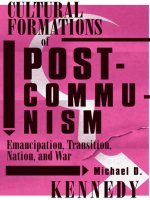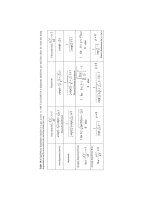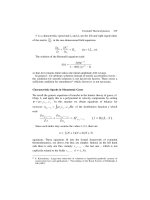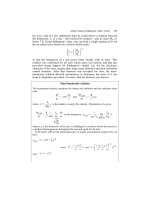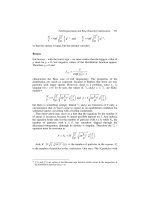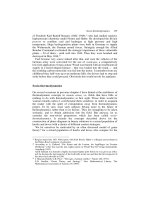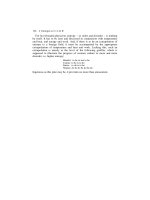Ideas of nation and malayness in malaya 1809 1942 a history of inclusion and exclusion
Bạn đang xem bản rút gọn của tài liệu. Xem và tải ngay bản đầy đủ của tài liệu tại đây (690.16 KB, 134 trang )
IDEAS OF NATION AND MALAYNESS IN MALAYA 1809-1942:
A HISTORY OF INCLUSION AND EXCLUSION
SANDRA KHOR MANICKAM
(B. A. HISTORY (HONS.), B. A. ECONOMICS (HONS.),
UNIVERSITY OF SOUTHERN CALIFORNIA)
A THESIS SUBMITTED FOR THE DEGREE OF MASTER OF ARTS
DEPARTMENT OF HISTORY
NATIONAL UNIVERSITY OF SINGAPORE
2005
ii
Acknowledgements
This thesis was made possible by the kind assistance offered by several institutions and
individuals. The Institute of Southeast Asian Studies in Singapore, Institute of the Malay
World and Civilisation at the National University of Malaysia and University of Malaya
made their libraries available to me which facilitated the completion of this thesis. The
assistance of Timothy P. Barnard and Mark Emmanuel was also invaluable. Without the
aid of their Jawi Transliteration Project (R-110-000-012-112), this thesis would not have
been completed.
For their supervision and suggestions, I extend my warmest thanks to Albert Lau and
Timothy P. Barnard. I am grateful for the support of Ian Gordon, Paul Kratoska and Kelly
Lau. I would also like to thank Philippa Levine for her encouragement and ideas from
afar.
The Singapore Buddies, the Lunch Girls, the graduate students of the History Department
and my parents have all made my stay in Singapore a pleasure. Last but not least, thanks
to Hoofd Ingrid Maria for being my companion throughout the journey.
iii
Table of Contents
Introduction:
Studies of nation and studies of Malayness - Points of convergence
1
Chapter 1:
British knowledge formation on Malaya through the lens of nation Drawing boundaries
17
Chapter 2:
Malays and Chinese “Others” in British Thinking of Malaya
36
Chapter 3:
Court Writings in the Malay Archipelago - Different Worlds
54
Chapter 4:
Malay Intellectuals - Changing Meanings of Malayness
70
Chapter 5:
Malayness and Nation - Tools in the formation of an independent state
94
Conclusion:
The Persistence of Ideas of Nation and Malayness
114
Bibliography
118
iv
Summary
This thesis looks at the constitution of ideas of ‘nation’ and ‘Malayness’ by British,
Malay and later, American authors. Nation and Malayness have typically been studied as
inclusive and static. In combination, these terms are often equated to a ‘Malay nation’ or
a ‘nation in Malaya’, both of which are imbued with late twentieth century
understandings of Malayness. This thesis argues, however, that the meanings of these
terms underwent change in the period in question, and exclusions were integral to the
establishment of the their meanings.
From 1809 to 1942, nation and Malayness were used strategically to further aims such as
perpetuating colonialism, building a community and gaining independence. Particular
understandings of the terms supported by British and Malay writers shared a similar basis
in placing a group defined as Malays as the only indigenous group in Malaya. This
construction of a native Malay subject, however, was made in opposition to groups
defined as not Malay such as Chinese and Indians. Thus, in the early twentieth century,
ideas of nation and Malayness on the Malay Peninsula resulted in the exclusion of
particular groups of people from being thought as belonging to Malaya.
When nation and Malayness were used in the 1930s and 40s to argue for independence,
previous exclusions were incorporated into authors’ visions of an independent state. Both
concepts were tools to exclude those who were seen as threatening or not belonging to a
Malay nation in Malaya. These exclusions gained legitimacy with the doctrine of national
self-determination. The doctrine placed the rights of indigenous people as paramount in
determining the basis on which governance should be established, and naturalised the
exclusions affected by the construction of an indigenous people. Thus prior to the
Japanese Occupation of Malaya, a ‘nation in Malaya’ was synonymous with a ‘Malay
nation’.
These insights draw attention to nation and Malayness not as natural and ever-present,
but as historically contingent. The presentation of nation as the main source of individual
identification throughout time, and of Malayness as essentialised and racialised, are thus
called into question. In the context of Malaya, the use of both terms were varied and
strategic in order to affect particular exclusions which continue until today.
1
Introduction:
Studies of nation and studies of Malayness - Points of convergence
In an opinion article published in 2004 in the International Herald Tribune
entitled “When the Malays cast their votes”, the author, Philip Bowring, writes:
“This year more Malays have participated in reasonably free and fair national
elections than will vote in the U.S. presidential election in November. …Of the
four predominantly Malay nations [Malaysia, the Philippines, Indonesia and
Brunei], … only the tiny oil rich sultanate of Brunei cannot pass as a democracy.
Is this a happy coincidence or a cultural statement with political and ethnic
implications for the region?”1
Bowring’s article represents a ‘popular’ understanding of the meaning of the terms
‘Malay’ and ‘nation’, and their relationship to political entities today. His use of ‘Malay’
misleadingly evokes the idea of one ethnic base indigenous to the Malay Archipelago
which coalesced into separate present day states. No mention is made of other ethnic
groups who are citizens of these countries, or who have long been present in the
Archipelago. The Chinese are specifically excluded from being considered indigenous
since they are linked to another ethnic type and state. Bowring’s understandings of the
Chinese is in opposition to his classification of Malays. Thus, he states that “China’s
ambitions to control the South China Sea remains very much on the table to the
discomfort to the Malays who occupy most of its coastline.” Finally, ‘nation’ seems to be
a mixture of current states overlapping with a singular ethnic group, thereby making
those states synonymous with a particular group.
1
Philip Bowring, “When the Malays cast their votes”, in International Herald Tribune, Wednesday, July
14, 2004, p. 7.
2
Bowring’s article illustrates the persistence of the links established between ideas
of Malayness (or the condition of being Malay) and of nation which effects particular
exclusions. Groups not considered as part of those terms are omitted from mention in the
machinery of modern statehood and its history, or are presented as threatening elements.
Nor is the article’s approach foreign to politicians in Malaysia itself. Khoo Boo Teik
writes that in 2000, “casting about for a solution to the persistence of ‘Malay disunity’,
[then Prime Minister] Mahathir tried playing the card that UMNO [United Malays
National Organisation] habitually dusted off its’ shelves when the party was in trouble:
the contrivance of a ‘Chinese threat’ to ‘Malay rights’.”2 The spectre of Chinese hostile
towards Malays was evoked in order to implore Malays to support the political party in
power. This was done by implying that the resulting unity would keep the Chinese
population in check and would protect the Malay-centred foundations of Malaysia by
extension. The Chinese, though citizens of Malaysia, are again seen as at odds with the
assumed ethnic base of the country.
The conceptions of nation and Malayness which naturalise exclusions of
particular groups is explained partly by the way in which these terms are rendered static
by many scholars. Nations are often studied as unchanging objects, instead of amorphous
groupings. Definitions of the nation are offered so that the scholar is clear about the
subject under consideration, often making the nation a category that stands outside of
historical influences. The attempt to delimit the nation results in contradictory definitions,
or a plurality of ‘types’ of nations which are also rigid and essentialised.3 Furthermore, if
2
Khoo Boo Teik, Beyond Mahathir: Malaysian Politics and its Discontents (London: Zed Books, 2003), p.
126.
3
See for instance the number of definitions offered in Nationalism, ed. John Hutchinson and Anthony D.
Smith (Oxford: Oxford University Press, 1994) and the insistence of Walker Connor that most scholars use
3
the nation is historicized, it is still studied as an object, albeit one that came about through
historically inevitable forces. This approach is seen most clearly in the philosophy of
Anthony D. Smith where he categorises loyalty towards the nation, nationalism, as a
“powerful current, a vital force based on vivid sentiments and attachments to a preexisting nation.”4 Though respectful of claims of nationalists, his approach does not
explain why that “pre-existing nation” is of such interest at a particular point in time,
particularly in the context of calls for state autonomy.5 Another aspect of nation studies is
that the term is a signifier for those included in the group, instead of those not included.
The emphasis on the former aspect of nation hides the other effect of delimiting groups,
which is identifying who does not share membership.
These common features of many studies on nation are also present in studies of
Malayness. The condition of being Malay, which goes beyond simple ethnic
categorisation, or Malayness, is presented in many studies as a clearly-defined and static
group. This rhetorical device enables the scholar to talk of ‘Malays’ in the eighteenth
century, for instance, and ‘Malays’ in Malaysia today in the same breath, referring to a
supposedly similar group of people with the same cultural features. Parallel to studies of
nation, even when Malayness is not assumed to be the same in the past as it is in the
present, the process by which the present group of Malays (or rather, present
understandings of what Malayness is) came about is seen to be historically inevitable.
Thus, even though the issues defining Malays in Malaysia today revolve around adat
‘nation’ incorrectly. Walker Connor, “A Nation is a Nation, Is a State, Is an Ethnic Group, Is a…,” Walker
Connor, Ethnonationalism: The Quest for Understanding (Princeton: Princeton University Press, 1994), pp.
91, 103.
4
Anthony D. Smith, “Introduction: Ethnicity and Nationalism,” in Ethnicity and Nationalism, ed. Anthony
D. Smith (Leiden: E. J. Brill, 1992), pp. 1-3.
5
Anthony P. Cohen, The Symbolic Construction of Community (London: Tavistock Publications, 1985), p.
104.
4
(culture), bahasa (language) and raja (king) were not necessarily present in the past, the
hegemony of this definition legitimises its usage in reference to the past as well.6 Finally,
Malayness is approached as an inclusive categorisation. This use of the term appears selfevident, especially when Malayness is understood to mean membership in an ethnic
group, itself approached as a static object. The presentation of Malayness and ethnic
groups in general as delimited and natural diminishes the aspect of identification with
these groupings as a process which also entails perpetuating exclusions.
In addition to these ways of studying ‘nation’ and ‘Malayness’ separately, there
are studies which marry the terms in two ways, though both render certain exclusions
inherent. Firstly, they are combined as ‘Malay nation’. Two extensive and important
studies of nation in Malaya, William R. Roff’s The Origins of Malay Nationalism and
Anthony Milner’s Invention of Politics in Colonial Malaya, both talk specifically about
Malays and a nation of Malays.7 Secondly, the terms are combined as ‘nation in Malaya’
although the phrase is commonly understood to refer to a Malay nation, thus naturalising
a particular ethnic base of nation in Malaya.8 The elements of a nation in modern
Malaysia which takes Malay identity as its base, bordering Chinese and Indians from that
nation, is reflected in studies such as T. H. Silcock and Ungku Abdul Aziz’s Asian
Nationalism and the West, where the emphasis on loyalty towards a nation based on a
6
Shamsul A. B., “The Construction and Transformation of a Social Identity: Malayness and
Bumiputeraness Re-examined” in Shamsul A. B., Two Recent Essays in Identity Formation in Malaysia
(Bangi: University Kebangsaan Malaysia, 1997), pp. 15-33. Zainal Abidin bin Abdul Wahid, Sejarah
Malaysia: Pentafsiran dan Penulisan (Bangi: Penerbit Universiti Kebangsaan Malaysia, 1992), p. 11
7
William R. Roff, The Origins of Malay Nationalism (Kuala Lumpur: University of Malaya Press, 1967);
Anthony C. Milner, The Invention of Politics in Colonial Malaya: Contesting Nationalism and the
expansion of the Public Sphere (Cambridge: Cambridge University Press, 1995).
8
Adrian Vickers, “‘Malay identity’: Modernity, Invented Tradition, and Forms of Knowledge,” in
Contesting Malayness: Malay Identity Across Boundaries, ed. Timothy P. Barnard (Singapore: Singapore
University Press, 2004), p. 40.
5
Malay ethnicity is taken for granted.9 These writings reflect an established scholarly
perception of a nation in Malaya as equivalent to a Malay nation.
In a critique on such studies that look at nation and Malayness as static or
historically inevitable objects, this thesis will argue that the terms are instead ideological
frameworks employed for various exclusionary ends. This approach highlights that there
could be influences on conceptions of nation and that those concepts are changeable,
thereby explaining shifts in definition and use. For example, Eric Hobsbawm’s wellknown axiom that nationalism creates nations instead of the other way around is borne
out of the view that conceptions of ‘nation’ vary according to different individuals.10
Furthermore, Benedict Anderson’s phrase “imagined community” in describing nations
emphasizes, among other things, nation as an understanding of community that groups of
people, particularly intellectuals, contribute to perpetuating.11 How these conceptions of
nation have been used are also open to scrutiny, with these works calling attention to the
ways in which rhetoric surrounding the nation is used to legitimise a variety of aims. As
9
T. H. Silcock and Ungku Abdul Aziz, “Nationalism in Malaya” in Asian Nationalism and the West: A
Symposium Based on Documents and Reports of the Eleventh Conference Institute of Pacific Relations, ed.
William L. Holland (New York: Octagon Books, 1973), pp. 269-346.
10
Eric J. Hobsbawm, Nations and Nationalisms since 1780: Programme, Myth, Reality (Cambridge:
Cambridge University Press, 1990), p. 10.
11
Benedict Anderson, Imagined Communities: reflections on the origins and the spread of nationalism
(London: Verso, 1991), pp. 6, 40, 46; Dominique Schnapper, Community of Citizens: On the Modern Idea
of Nationality, with a preface by Daniel Bell, translated from the French by Severine Rosee (New
Brunswick: Transaction Publishers, 1998), p. 147; Intellectuals and the Articulation of the Nation, ed.
Michael D. Kennedy and Ronald Grigor Suny (Ann Arbor: University of Michigan Press, 1999), p. 2.
“Imagined” in Anderson’s usage, and “ideological framework” as used here is not meant to connote
“fabrication”, “falsity” or “unreality”. Such a comparison implies that there are “true communities
exist[ing] which can be advantageously juxtaposed to nations”, a stand which is not taken here. The
approach to nation as an ideology is underscored by Balibar who says that “every social community
reproduced by the functioning of institutions is imaginary, that is to say, it is based on the projection of
individual existence into the weft of a collective narrative, on the recognition of a common name and on
traditions lived as the trace of an immemorial past (even when they have been fabricated and inculcated in
the recent past). But this comes down to accepting that under certain conditions, only imaginary
communities are real (original emphasis).” Etienne Balibar, “The Nation Form: History and Ideology,” in
Etienne Balibar and Immanuel Wallerstein, Race, Nation and Class: Ambiguous Identities, trans. Chris
Turner (London: Verso, 1991), p. 93.
6
early as 1882, concepts of nation were used to support claims to territorial acquisition.
Ernest Renan’s insistence on a nation based on common experience though not
necessarily of common ethnicity, was met with Theodor Mommsen’s ethnicity-based
nation. While Renan’s definition supported France’s claim to territories annexed by
Germany by saying that the people in those territories shared the will to come together,
Mommsen’s definition supported Germany’s case for annexation based on assertions of
common ethnicity. 12 Therefore, to assert the presence of nation with particular
delimitations was, and continues to be, strategic.
Part of the strategy surrounding the claim of nationhood is the implicit placement
of borders surrounding this entity so as to exclude certain people. Nation is often
expressed in inclusive terms with people referred to as a part of the nation based on
particular characteristics. Those features are then falsely assumed to be common to all
people. These two aspects of the presentation of nation are referred to by Thongchai
Winichakul as the “positive identification” markers of those in the nation.13 Part of the
effect of attributing characteristics to nations is to link and naturalize those
characteristics. The components are talked about in unison, leaving little doubt as to why
those components fit together. This typical manner of describing the nation obscures its
exclusivity. Studies by Anthony W. Marx and Uday S. Mehta argue that ideas of nation
are tailored specifically to exclude groups of people while assuming the facade of being
inclusive.14 In fact, the discourse of inclusiveness assumes exclusions from the start, with
12
Nationalism, p. 17; Schnapper, Community of Citizens, pp. 136, 140; Hobsbawm, Nations and
Nationalisms since 1780, p. 6.
13
Thongchai Winichakul, Siam Mapped: A History of the Geo-body of the nation (Chiangmai: Silkworm
Books, 1994), pp. 3, 5.
14
Uday S. Mehta, “Liberal Strategies of Exclusion” in Tensions of Empire: Colonial Cultures in a
Bourgeois World, ed. Frederick Cooper and Ann Laura Stoler (Berkeley: University California Press,
1997), pp. 60-1; Anthony W. Marx, Faith in Nation: Exclusionary Origins of Nationalism (Oxford: Oxford
7
the drive to bring together a section of the population though emphasizing antagonisms
against an enemy made common.
There are studies on ethnicity, and Malayness in particular, that have also arrived
at similar conclusions. Instead of seeing ethnicity as an object, these studies approach it
as “a product of particular historical conditions, and not an ontological feature of human
organisation.”15 Thus, ethnicity is seen as an on-going process of individual identification
to a larger grouping.16 These two insights bring forth an understanding of ethnicity that is
individual and historically specific. Indeed, the contributing authors to Contesting
Malayness show that a Malay ethnicity, or identification as Malay, cannot be
essentialised since it could mean different things for people in different positions, making
it difficult to talk about Malays in eighteenth century Malaya and Malays in modern
Malaysia as a similar group.17
In the constitution of ethnicity, authors such as John Comaroff and Thongchai
have noted that a group identity is asserted against the projection of a group seemed as
dissimilar. Comaroff terms this strategy as “othering” whereby “‘otherness,’ then,
becomes a contrivance in the counter image of social selfhood, not an empirical
description of any particular population.”18 Fredrik Barth and Anthony Cohen’s studies
on ethnicity focus on the point of differentiation, or the issue over which a distinction is
made between ‘us’ and ‘them’. They note that an aspect of ethnic group formation, and of
University Press, 2002), pp. vii, ix. Also see Patriotism: The Making and Unmaking of British National
Identity, Volume I: History and Politics, Volume II: Minorities and Outsiders, Volume III: National
Fictions, ed. Raphael Samuel (London: Routledge, 1989).
15
John L. Comaroff, “Of Totemism and Ethnicity: Consciousness, Practice and the Signs of Inequality,”
Ethnos, Vol. 52: III-IV (1987): 302.
16
Richard Jenkins, Social Identities, second edition (London: Routledge, 2004), p. 88.
17
Contesting Malayness: Malay Identity Across Boundaries, ed. Timothy P. Barnard (Singapore: Singapore
University Press, 2004).
18
Comaroff, “Of Totemism and Ethnicity ”, p. 309.
8
community formation in general, is through instances of boundary maintenance. The
objective characteristics that serve as markers of a community may change, but
boundaries are still maintained versus groups perceived as other.19 Thus there is a range
of expressions of community depending on which parties are threatening at certain time
periods, though the reference is still towards one community, the Malays.20 The
implications of this malleability of community is that the meaning and implications of
Malayness changes depending on the authors and the historical circumstances of their
writings. Thus, Malayness is not a static object of enquiry, but rather it is a process of
identification that is continually changing and being changed.21 In this study then,
boundary maintenance between Malayness and a group constructed as ‘Chinese’ will be
the main focus.22
In the use of both terms, there was a convergence of strategies. Ideas of nation
and Malayness were both used to further the aims of authors writing about them. The
unities instilled through particular definitions and uses of nation and Malayness were
indicative of the exclusions affected by them which were also strategic. In Malaya in the
nineteenth and early twentieth centuries, Chinese were excluded from these terms at
various points by prominent writers and intellectuals. The reasons for bordering this
19
Fredrik Barth, “Introduction” in Ethnic Groups and Boundaries: The Social Organization of Cultural
Difference, ed. Fredrik Barth (London: George Allen & Unwin, 1970), pp. 14-5; Anthony P. Cohen,
“Introduction: Discriminating relations: identity, boundary and authenticity” in Signifying Identities:
Anthropological Perspectives on Boundaries and Contested Values, ed. Anthony Cohen (London:
Routledge, 2000), p. 1.
20
Cohen, The Symbolic Construction of Community, pp. 116, 118.
21
Jenkins, Social Identities, p. 88.
22
There were other groups constructed as ‘others’ of Malayness, for instance Muslims of Arab and Indian
origin. However, this study focuses instead on Chinese and to some extent non-Muslim Indians due to the
prominent stereotype of these groups as being a major threat to the existence of Malays during the period of
British influence and even in Malaysia today. Also because there were groups othered from Malays who
were Muslim, religious difference is not approached as an objective characteristic dividing groups
constituted as Malay and Chinese. Rather, the dichotomy between Muslims and non-Muslims is shown to
have been highlighted strategically and linked to perceptions of threat and of other differences.
9
group depended on who was using the terms, and the circumstances of their writing. In
the twentieth century, there was an overlap of meanings of nation and Malayness as used
by various authors. This contributed to the notion that the marriage of the terms in
reference to Malaya was either as a Malay nation, or a nation in Malaya universalised as
based on Malayness, with Malays as an ethnic object delimited against other static
groups, in particular, Chinese. The persuasiveness of these specific understandings of
nation in Malaya was supported by prior British knowledge and new notions of selfdetermination which privileged an understanding of nation as a ‘indigenous self’. The
over-lapping positions of scholars using ‘nation’ and ‘Malayness’ as ideological
frameworks show the interaction between spheres of knowledge production which
perpetuate certain exclusions. These points of convergence between scholars within
Malaya and without had long-lasting effects on perceptions of groups in relation to
Malaya and the future Malaysia.
*
Chapter One of this thesis addresses the manner in which nation was used
strategically through definitions of nation, and the identification of the presence (or
absence) of nation, in Malaya. A comparison of British authors’ ideas of nation in Malaya
from 1809 to 1891 will show that ideas of nation coming from Europe were varied and
contradictory. Definitions offered by British writers were infused with their own
perceptions of unities of peoples, governments, and cultures in Malaya, and what lay
outside those unities. Rationales for including certain groups were followed by rationales
10
for excluding others. These exclusions were not uniform from author to author, or even
within an author’s work, calling into question just how ‘rational’ those exclusions were.
In fact, both inclusions and exclusions in nation were contingent upon the circumstances
of their knowledge production and how information could be put to use by the authors.
The reliance of nation identification and delimitation by the scholar was brought into
sharper relief when, in the late nineteenth century, circumstances of the British in Malaya
changed and scholars agreed that there was never a nation in Malaya. Hence, definitions
and identification of nation were far from natural, and were dependent on scholars’
constructions, often with contradictory claims.
While establishing that ideas of nation depended on the perceptions of the
authors, the question then shifts to how certain perceptions of nation in Malaya, with
Malays as the defining characteristic of that nation, became established. Chapter Two ties
this to British knowledge formation of Malaya and Malays. During the late nineteenth
and early twentieth centuries, when Malaya was under either British protection or
colonization, Malays were thought of primarily as an indigenous ethnic group. Chinese in
particular were presented as the opposite of Malays, in contrast to all that was native to
Malaya. The dichotomising of Chinese from Malays, and characteristics epitomised by
the Chinese from those similarly represented by Malays, was a building block of racial
categorisation. Notions of ethnicity and indigenousness promoted by the British during
this time were extremely influential in determining ideas of who was Malay and thus
native, and later, who was included in a nation in Malaya.
Although ascriptions of nationhood changed, a Malay nation was assumed to be
present when British and Malay authors of the early twentieth century wrote about the
11
pre-colonial history of Malaya and the history of sultanates in the Peninsula. Recent
authors also project the nation into the past. For instance, Zainal Abidin bin Abdul Wahid
writes that “Malay nationalism had already existed during the Melaka Malay
Sultanate…”. The nation is perceived as a Malay one, with Malay sultans and royalty in
control of ruling and government in a defined political sphere, and a base society of
Malay subjects.23 These writings not only place the nation outside of history, they also
impose Western and present day conceptions of nation and polities on historical
communities that defy such interpretations. Chapter Three takes examples from three
court-centred texts and illustrates the different ways community was organised in
nineteenth century Malay Archipelago. The organisation of polities did not depend solely
on the similar ethnic category of rulers and their subjects. Instead, there is evidence to
suggest that groups other than what were called Malays in these texts participated in, and
were regarded as loyal subjects by, the sultanates. These texts force us to question the
connections between Malays, Malaya and governance which place groups not seen as
Malay and indigenous outside of definitions of government, indigenous and nation.
The texts in Chapter Three are also dynamic in that they attempted to present
alternate versions of their communities. The last text considered in that chapter, Tuhfat
al-Nafis, reflects an endeavour to rework the meaning of Malay by a court scribe. Raja
Ali Haji’s formulation of what it means to be Malay, or Malayness, includes the Bugis in
the links between Malays, royalty and the authority to govern in the Archipelago. He
23
Rupert Emerson, Malaysia: A Study in Direct and Indirect Rule (Kuala Lumpur: University of Malaya
Press, 1964), pp. 17, 19, 143; Zainal Abidin, Sejarah Malaysia, p. 11; Za’ba, Sejarah Ringkas Tanah
Melayu, dikutip dan diterjemah dari bahagian-bahagian yang menasabah dalam buku “Malaya” karangan
Dr. R. O. Winstedt (yang terbit pada tahun 1922) (Singapura: Pustaka Melayu, 1961), p. 117.
12
rewrote the boundaries of Malayness in ways that reflected his discontent with a term that
excluded himself from the privileges afforded to Malay royalty during his time.24
The rewriting of the boundaries of Malayness when responding to perceived
marginalisation and threats in the late nineteenth and early twentieth centuries is traced in
Chapter Four. In that chapter, Malayness, and later understandings of a nation based on
Malayness, is shown to have different variants. In studies of nationalism in Malaya, the
components that make up the Malay base are often taken for granted. Roff’s study was a
landmark work on nationalism in Malaya. The book’s use of a new range of sources and
the focus on different groups’ contribution to Malay nationalism provides scholars with
much to think about and continues to be influential thirty years after the appearance of his
study. Roff traces the origins of Malay nationalism by taking the category of Malays, as
well as nationalism and nation, as an object of study from the eighteenth to nineteenth
centuries of Malaya. The composition of that category, however, is not elucidated and in
several instances appears static and self-explanatory. Muslims of Indian and Arab origin,
as well as foreign Malays from outside of the Peninsula, are often subsumed under the
category of Malays.25
The inclusion of particular groups as Malay is problematic as such definitions
were fluid during the period in question. Groups may or may not have been considered
Malay depending on the authors’ understanding of the community. Indeed, some authors
framed Malay in such a way as to prohibit entry of particular groups from the category
24
Virginia Hooker, “Riau-Lingga Writers” in Early Modern History, ed. Anthony Reid (Singapore:
Archipelago Press, 1999), p. 98; Raja Ali Haji bin Ahmad, The Precious Gift (Tuhfat al-Nafis), an
annotated translation by Virginia Matheson and Barbara Watson Andaya (Kuala Lumpur: Oxford
University Press, 1982); Jan van der Putten, “A Malay of Bugis Ancestry: Haji Ibrahim’s Strategies of
Survival” in Contesting Malayness: Malay Identity Across Boundaries, ed. Timothy P. Barnard (Singapore:
Singapore University Press, 2004), p. 123.
25
Roff, The Origins of Malay Nationalism, pp. 54-5.
13
similar to the way nation was employed by British authors. Just as Raja Ali Haji’s views
of Malayness in Chapter Three were affected by his position as a member of the Bugis
court in the Johor-Riau Sultanate, the range of ideas of Malayness as expressed by
authors at the turn of the century were influenced by particular circumstances in Malaya.
The perceived threat of “foreign races”, often identified as a Chinese mass, was a factor
in the conception of alliances and unities against those groups.
The ways in which meanings of Malayness and nation were both changed
strategically point to parallels in knowledge formation by British and Malay authors. This
can be linked to the context of Malaya in the early twentieth century, where Malayness
had a currency not dissimilar to nation as used by Western anti-imperialists during the
same time. For instance, when considering histories written in the 1920s with ideas of
Malayness at their centre, their rhetorical effect paralleled the effect of histories of nation
as used by Western anti-imperialists. Some terms connoting groupings of people such as
bangsa or orang Melayu, and others referring to the Peninsula geographically or a
homeland such as tanahair, watan and semenanjung, were spread through many Malay
histories and creative literary works. The links forged by such a range of terms with
Malays and Malaya, however, similarly connoted a privileged place in Malaya for the
Malays. The last work considered in Chapter Four was written by Abdul Majid
Zainuddin, a history that used the term nation to bear on matters of rights and privileges
in government and economy.26
Divergences are equally apparent. Though ethnic categories were applied by both
British and Malays to people in Malaya, the former use of race connoted a lessening of
26
The Malays in Malaya, by One of Them (Singapore: Printed at the Malaya Publishing House, Ltd., 1928),
pp. 90-4; The Wandering Thoughts of a Dying Man: The Life and Times of Haji Abdul Majid bin
Zainuddin, ed. William R. Roff (Kuala Lumpur: Oxford University Press, 1978), pp. 159-160.
14
power in terms of the way Malays and Malaya were perceived, while the latter
application enabled the authors to call for Malaya-wide unities. The presentations of
Malaya in the 1920s by Malay authors drawing from British knowledge were infused
with a sense of autonomy not present in British writings. Abdul Majid’s history of
Malaya written in 1928 established major components of a nation seen in Malaysia today.
He approached the nation in Malaya as deserving of the status of other nations in the
world, with rights such as sovereignty and participation in government for the nation’s
people. At the same time, Abdul Majid’s use of the terminology of nation and modern
statehood diverged from that seen in Western anti-imperialists narratives that saw
nationalism as a vehicle for the independence struggle.
Interactions can be seen between Abdul Majid’s book and the American work on
Malaya by L. Richmond Wheeler to which Abdul Majid was responding. Wheeler
introduced another way of viewing Malaya which was influenced by British ideas
concerning Malays and the early twentieth century anti-imperialism stance held by a
handful of Western scholars. The latter viewpoint entertained the notion that nations
might be formed, or were already present, in colonised countries, and that selfgovernment or independence was the appropriate state of government for nations.27
Abdul Majid, however, did not use the history of an autonomous nation to oppose the
way the British were governing Malaya. Instead, he used it to argue that other groups in
Malaya, namely Chinese and Indians, should not be allowed to participate in governing
Malaya. These similarities and differences between Malay, British and American writings
point to Malay authors not merely attempting to imitate ideas of nation from Europe.
27
L. Richmond Wheeler , The Modern Malay (London: George Allen & Unwin Ltd., 1928), pp. 7, 111,
180, 235.
15
Rather, Malay authors brought their own concerns to their formulations at particular
points in history.
Chapter Five deals with the convergence of different axes of thought in the 1930s
and 1940s in establishing the idea of nation in Malaya as being a Malay nation and
excluding the Chinese in particular. In comparing two pairs of works supposedly
produced in separate spheres, similar inclusions and exclusions were evoked in
presenting a nation in Malaya concerned with rights. Against the background of nonMalays arguing for access to positions in government in Malaya, as well as asserting that
they should have the same rights in Malaya that Malays have, Ishak Haji Muhammad’s
novel Putera Gunung Tahan asserts the non-negotiable status of Malay rights to
government and economic holdings, while also attacking colonialism. Rupert Emerson’s
Malaysia: A Study in Direct and Indirect Rule acknowledges that the call for rights by
representatives of Chinese in Malaya as natives of Malaya are not without their merits,
but he finds it difficult to agree with Chinese rights.28 The rights of Chinese and nonMalays in general were being called into doubt based on the strength of their claims as
compared against established knowledge.
Over-arching claims were made about the nation in Malaya during this time,
which had resonance with the way nations were asserted elsewhere in the fight for
independence. The claim that nation was a unity of people who knew themselves to be
connected was presented by writers as a way of galvanising support for anti-colonial
movements. This individual attachment to the supposedly self-evident community and
object of the nation, often called nationalism, is supported even today by scholars such as
28
Ishak Haji Muhammad, Putera Gunung Tahan (Petaling Jaya: Pustaka Budaya Agency, 1973), pp. 5859, 69, 78; Emerson, Malaysia, p. 263.
16
Smith and Walker Connor. A comparison is made between the assertions of the unity of
“the people” in nation in Emerson’s “Introduction” to Government and Nationalism in
Southeast Asia and in Ibrahim Yaakob’s Melihat Tanahair.29 The assumption by scholars
against colonialism and by nationalists that there is or should be a unity in nation is
juxtaposed against the testament of disunity which threatens the rhetoric of nation. These
texts show that the idea of a unity in nation in the 1940s was used strategically by writers
in and outside of Malaya. The rhetorical device of asserting a unity, however, was
subsequently entrenched as a feature of a nation. This study concludes at the eve of the
Japanese occupation of Malaya, when the rhetoric of the primacy of Malays in Malaya,
and the exclusion of non-essential elements such as Chinese and Indians, was persuasive
inside and outside of Malaya.
29
Rupert Emerson, “Introduction,” in Institute of Pacific Relations Inquiry Series, Government and
Nationalism in Southeast Asia (New York: Institute of Pacific Relations, 1942); Ibrahim Haji Yaakob,
Melihat Tanahair (Kuantan: Percetakan Timur, 1975).
17
Chapter 1:
British knowledge formation on Malaya through the lens of nation Drawing boundaries
In an essay to the Asiatic Society in Calcutta at the beginning of the nineteenth
century, Sir Thomas Stamford Raffles, then Governor of Java, wrote:
“I cannot but consider the Malayan nation as one people, speaking one language,
though spread over so wide a space, and preserving their character and customs,
in all the maritime states lying between the Sula Seas and the Southern Ocean,
and bounded longitudinally by Sumatra and the western side of Papua or New
Guinea”.1
At the end of the same century, in 1891, William E. Maxwell at a talk at the Royal
Colonial Institute in London declared:
“There has never been, at any time known to history, a Malay nation strictly so
called; that is to say, one people acknowledging one supreme chief or ruler,
obeying one central government, and governed by one body of customary law”.2
While the authors promoted dissimilar theories of unities, they both articulated the nation
as the basic category under consideration. Nation was used to describe a group of people,
and to describe the things shared by those within that group that made them into a nation.
The differences between these two statements are obvious. If we merely focus on the
application of the word ‘nation’, the divergence between the two views lies in the former
asserting the presence of a nation in the Malay Archipelago, and the latter negating that
there ever was a nation in the Archipelago, and particularly the Malay Peninsula. The
1
Lady Sophia Raffles, Memoir of the Life and Public Services of Sir Thomas Stanford Raffles (Singapore:
Oxford University Press, 1991), p. 15.
2
W. E. Maxwell, “The Malay Peninsula: Its Resources and Prospects”, in Honourable Intentions: Talks on
the British Empire in South-east Asia delivered at the Royal Colonial Institute 1874-1928, ed. Paul H.
Kratoska (Singapore: Oxford University Press, 1983), pp. 125, 128.
18
gulf separating Raffles’ and Maxwell’s statements does not, however, end there. Both
authors did not talk about the category ‘nation’ in similar terms. To Raffles, the nation
embodied a unity of a group of people through a similar language and customs. To
Maxwell, the unity of a people was dependent on a specific mode of ruling and
government over a designated territory where the people are found.
Raffles and Maxwell presented two versions of nation that were supposed to be
applicable to the Malay Peninsula during a similar time period. Understanding nation as
an ideological framework allows for a better understanding of the differences between
Raffles and Maxwell’s statements. They are indicative of the separate contexts in which
the authors were writing which were related to furthering British interests in Malaya. One
of the effects of the knowledge produced concerning nation in Malaya was to establish
assumptions about the people in Malaya by naturalizing the inclusion of some people as
native and the exclusion of others as foreign at different times and in different contexts.
The role of knowledge produced by those aligned to colonising forces in
furthering such interests has been a subject of great interest among scholars.3 Knowledge
production by British authors concerning the Malay Peninsula in particular was closely
tied to British territorial acquisitions in the Peninsula during the nineteenth century.
During this time, the British government and Malay polities began more extensive
political relations than had hitherto been known. Prior to the nineteenth century, other
European powers had made their influence felt in the Peninsula. In 1511, the Portuguese
captured Melaka, which then passed to the Dutch in the seventeenth century. In the
3
See Chapters Three and Four in Bernard S. Cohn, Colonialism and Its Forms of Knowledge: The British
in India, (Princeton: Princeton University Press, 1996) and Olufemi Taiwo, “Reading the Colonizer’s
Mind: Lord Lugard and the Philosophical Foundations of British Colonialism,” in Racism and Philosophy,
ed. Susan E. Babbitt and Sue Campbell (Ithaca: Cornell University Press, 1999), pp. 157-86.
19
eighteenth century, however, Dutch power was in decline, and there were increasing
contacts between private traders from Britain and the Archipelago. In the late eighteenth
century, the Sultan of Kedah hoped an alliance with British traders would keep Siamese
power over Kedah in check. As a result, Penang came into British possession in 1789.
The beginning of the nineteenth century saw the founding of Singapore by Raffles in
1819. Following the Anglo-Dutch treaty in 1824, which divided the Archipelago into two
separate spheres of influence, Melaka came under British power as well.4
With the involvement of British traders and administrators in the Peninsula came
reports and scholarly works concerning the area. Prior to the nineteenth century, trading
records were the main sources of information about the Peninsula. Now, British
administrators and those sharing an interest in Malaya amassed knowledge for
administrative purposes and for interested British readers.5 This was part of a scientific
endeavour to understand the region and Malays in a serious manner, which was related to
larger issues in the Scientific Revolution.6 The category ‘nation’ was among the terms
used to make sense of Malaya. While few British authors wrote specifically about nation
in Malaya, the impact of those authors was felt through the dependence of the colonial
machinery on knowledge Britons produced about Malaya. The writings of those such as
Raffles, John Leyden and John Crawfurd influenced ideas about what lay inside and
4
Barbara Watson Andaya and Leonard Y. Andaya, A History of Malaysia (London: Macmillan Press,
1982), pp. 100-22.
5
Andaya and Andaya, A History of Malaysia, p. 115.
6
Hendrik M. J. Maier, In the Centre of Authority: The Malay Hikayat Merong Mahawangsa (New York:
Southeast Asia Program, Cornell University, 1988), pp. 38, 43. It is a commonly held view that a Scientific
Revolution took place in the seventeenth century in Europe. This constituted a change in the way the world
was thought of by European scholars at the time, which impacted subsequent knowledge production in
Europe. In particular, Richard Westfall argues that the scientific revolution ushered in the belief that things
in nature were quantifiable, and its inner workings could be discovered via scientific methods (Richard S.
Westfall, “The scientific revolution of the seventeenth century: the construction of a new world view” in
The Concept of Nature: The Herbert Spencer Lectures, ed. John Torrance [Oxford: Clarendon Press, 1992],
pp. 63-93).
20
outside a Malay nation, and had a impact on subsequent British impressions of the
Peninsula. 7 The importance of the larger body of knowledge to which these men
contributed has even led Henk Maier to refer to the scholarship as “Malayist Studies”.8
New colonial officials referred to this knowledge upon arrival, thus setting the parameters
for their understanding. The knowledge was utilised in the training of cadets who would
be involved in the running of government affairs, and often had direct consequences on
the policies officials implemented.9
Raffles, Leyden and Crawfurd had a major influence on developing assumptions
concerning Malaya. As such, it is important to understand how and possibly why these
authors formulated nation the way they did. Raffles was as an administrator of the British
East India Company in Java and the founder of Singapore in 1819.10 To search for
definitions of nation in Raffles’ writing is difficult. Raffles, like other authors who
employed the term, rarely defined the nation outright.11 What is evident from his writings
are the characteristics which distinguished a particular nation. In a 1809 introduction to
his 1818 article, “On the Malayu Nation, with a Translation of its Maritime Institutions”,
there were certain criteria, such as language with written characters, a body of law, and
practiced customs, that Raffles applied in qualifying the presence of different nations in
7
Anthony Reid, “Understanding Melayu(Malay) as a Source of Diverse Modern Identities”, in Contesting
Malayness: Malay Identity Across Boundaries, ed. Timothy P. Barnard (Singapore: Singapore University
Press, 2004), pp. 295-314; Maier, In the Centre of Authority, p. 17.
8
Maier’s analysis of the knowledge formation by Malayists points to such an endeavour being academic
and intertextual. Maier, In the Centre of Authority, pp. 8-9.
9
R. J. Wilkinson, Papers on Malay Subjects, selected and introduced by P. L. Burns (Kuala Lumpur:
Oxford University Press, 1971), p. 2.
10
Raffles, Memoir of the Life and Public Services of Sir Thomas Stanford Raffles, p. v; John Crawfurd, A
Descriptive Dictionary of the Indian Islands & Adjacent Countries, with an introduction by M. C. Ricklefs
(Kuala Lumpur: Oxford University Press, 1971), p. v.
11
For example, see the work of Walter Bagehot, Physics and Politics (New York: The Colonial Press,
1899).
21
the Malay Archipelago.12 In another piece written in 1806, Raffles distinguished nations
by the different economic roles and foods the people consumed.13
In an article published in Asiatic Researches in 1808, John Leyden provided
another view of the main component a nation. Leyden was known in Scotland as a
scholar and writer of Scottish literature on par with Sir Walter Scott, a popular Scottish
writer, in the late eighteenth century.14 In line with many Scottish thinkers during that
time, the study of the origins of social artifacts, such as language, was said to yield
knowledge concerning the people who employed such artifacts.15 In his article entitled,
“On the Languages and Literatures of Indo-Chinese Nations”, Leyden drew links
between the Malay language as it was spoken and written in parts of the Malay Peninsula
and Sumatra, and the presence of a Malay nation. In general, he believed that a study of
language gave insights into the history of the nation.16 Such statements indicate the extent
to which Leyden viewed the nation and language as intertwined, incurring the problem
for the scholar of ascertaining the extent to which a nation can be said to exist solely on
the basis of the existence of a language.
Like Leyden, John Crawfurd was a Scotsman. He first came to Penang in 1808
where he began to study things Malay. He worked under Raffles in the British
administration in Java, and after the Dutch regained control of the island, Crawfurd
returned to England to write his History of the Indian Archipelago, which was published
12
Reid, “Understanding Melayu(Malay) as a Source of Diverse Modern Identities”, p. 303, f. 37; Raffles,
Memoir of the Life and Public Services of Sir Thomas Stanford Raffles, p. 15.
13
Raffles, Memoir of the Life and Public Services of Sir Thomas Stanford Raffles, p. 10.
14
Maier, In the Centre of Authority, p. 16; John Leyden’s Malay Annals, With an Introductory Essay by
Virginia Matheson Hooker and M. B. Hooker, MBRAS Reprint 20 (Selangor: MBRAS, 2001), p. 4.
15
Mary Catherine Quilty, Textual Empires: A Reading of Early British Histories of Southeast Asia
(Monash University: Monash Asia Institute, 1998), pp. 42-4.
16
John Leyden’s Malay Annals, pp. 26, 28-9.



